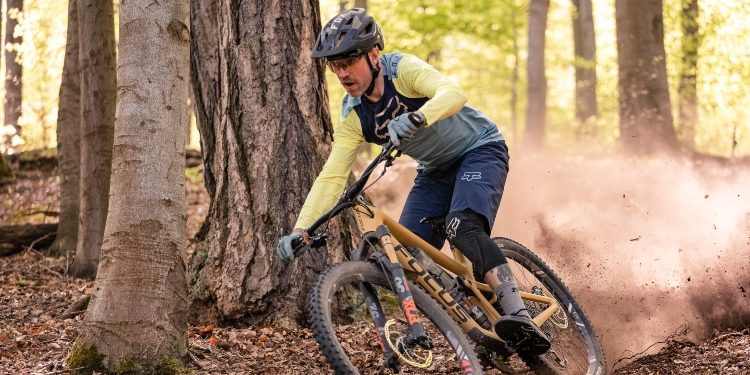Full-suspension mtbs (mountain bikes) are an absolute attraction that pro bikers seek. But what are they, what do they consist of, and how do they improve the riding experience?
Let’sLet’s find all that out in this piece together.
What Is A Full-Suspension Mountain Bike?
A full-suspension mountain bike is a type of mountain bike that features both front and rear suspension. This means the bike has a suspension fork on the front to absorb impacts from the front wheel and a rear shock to absorb the effects from the rear wheel.
The suspension allows the wheels to move independently of the frame, providing increased traction and comfort on rugged, off-road trails. Full-suspension mountain bikes are typically more expensive than hardtail mountain bikes, which only have front suspension but offer a more comfortable and efficient ride on rough terrain.
What Features are Unique to Full-Suspension Mountain Bikes
Some of the features that are unique to full-suspension mountain bikes include:
- Front and rear suspension: As the name suggests, the most apparent characteristic of a full-suspension mountain bike is its suspension on both the front and rear wheels. This allows the wheels to move independently of the frame, providing increased traction and comfort on rough trails.
- Linkage-driven rear suspension: Most full-suspension mountain bikes use a linkage-driven rear suspension design, which uses a series of pivots and linkages to create a suspension system that is both efficient and tuneable. This allows the rider to adjust the suspension to suit their weight, riding style, and trail conditions.
- Steeper head tube angle: Full suspension mountain bikes typically have a steeper head tube angle than hardtail bikes, which makes them more agile and responsive on technical trails. This allows the rider to make quick, sharp turns and easily navigate tight, twisty trails.
- Longer wheelbase: Full suspension mountain bikes often have a longer wheelbase than hardtail bikes, which provides increased stability at high speeds and on steep, rocky trails. This can help the rider maintain control and confidence on challenging terrain.
Advantages of a full-suspension mountain bike
Some of the advantages of a full-suspension mountain bike include the following that makes them better than a typical mountain bike:
- Increased comfort: The suspension on a full-suspension mountain bike allows the wheels to move independently of the frame, which helps to absorb impacts and vibrations from the trail. This can make the ride more comfortable and reduce fatigue on long rides.
- Increased traction: The suspension on a full-suspension mountain bike also allows the wheels to move independently of the frame, which can help to increase traction on rough, off-road trails. This can make the bike easier to control and more stable on challenging terrain.
- Improved efficiency: The suspension on a full-suspension mountain bike can also help make the cycle more efficient. The suspension absorbs some energy from bumps and irregularities in the trail, reducing the energy lost through the rider’s body. This can make it easier to maintain speed and momentum on the trail.
- Higher-quality components: Full-suspension mountain bikes are typically more expensive than hardtail bikes, so they are often made with higher-quality components and materials. This can result in a lighter, stronger, and more durable bicycle better suited to the demands of off-road riding.
Disadvantages of a full-suspension mountain bike
Some of the disadvantages of a full-suspension mountain bike include the following.
- Higher cost: One of the main disadvantages of a full-suspension mountain bike is that they are typically more expensive than hardtail bikes. This can make them less accessible for some riders, especially those on a tight budget.
- Added weight: Full-suspension mountain bikes are generally heavier than hardtail bikes because they have more complex suspension systems and additional components. This can make them more difficult to pedal uphill and less agile on the trail. They are not the best for young kids or people that need more strength to ride one uphill without struggling.
- Increased maintenance: Full-suspension mountain bikes have more moving parts than hardtail bikes, requiring more regular maintenance and servicing. This can add to the overall cost of ownership and may be a concern for some riders.
- Less efficient on smooth trails: The suspension on a full-suspension mountain bike is designed to absorb impacts and vibrations from the trail. This can make the bike feel less efficient on smooth, flat trails where the suspension is not being used. Some riders may prefer the stiff, responsive feel of a hardtail bike on these types of courses.
Bottom Line
There are so many types of mountain bikes out there we all need to understand why they are unique. Today we learned about full-suspension mountain bikes. What do you remember?
David Prior
David Prior is the editor of Today News, responsible for the overall editorial strategy. He is an NCTJ-qualified journalist with over 20 years’ experience, and is also editor of the award-winning hyperlocal news title Altrincham Today. His LinkedIn profile is here.













































































